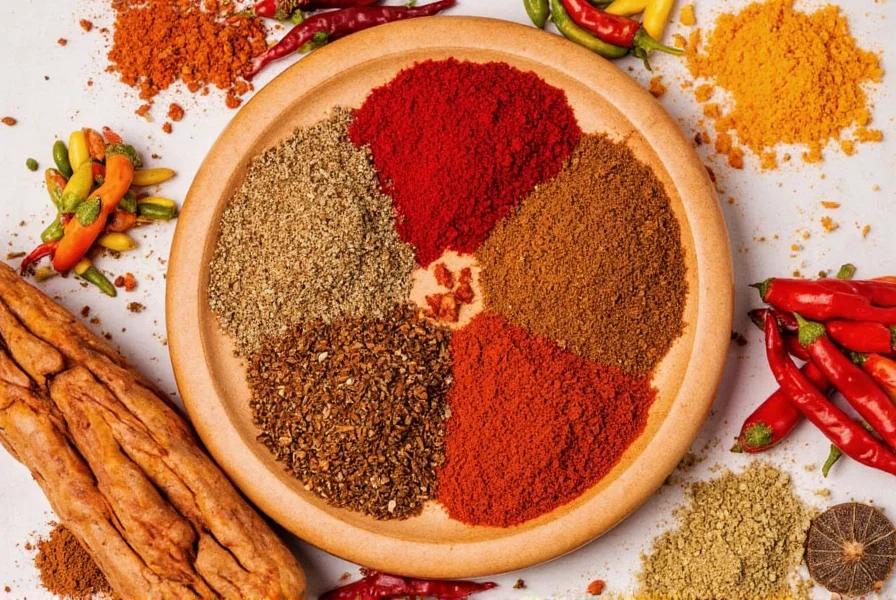Need an ancho chili powder substitute? Here are the top 7 alternatives with exact measurements, flavor profiles, and usage tips for perfect results in any recipe.

Top 7 Ancho Chili Powder Substitutes
Mulato Chili Powder
Made from dried mulato peppers, this is the closest match to ancho with deeper sweetness and earthy notes. Use 1:1 ratio for moles, stews, and braises.
Pasilla Negro Chile Powder
Offers fruity, licorice-like notes with moderate heat. Use sparingly (75% of ancho amount) in soups and baked goods.
Guajillo Chili Powder
Brighter and tangier than ancho with berry-like flavors. Ideal for salsas and marinades; use 1:1 ratio but reduce for heat-sensitive dishes.
Chipotle Powder
Intensely smoky and hot. Start with half the amount called for in recipes like BBQ rubs or grilled meats.
Paprika + Crushed Red Pepper Flakes
Quick pantry hack: 1 tsp smoked paprika + ¼ tsp red pepper flakes per 1 tsp ancho. Perfect for weeknight meals.
Ground Cumin + Cayenne Mix
For Tex-Mex dishes: 1 tsp cumin + pinch of cayenne per 1 tsp ancho. Not ideal for authentic Mexican recipes.
New Mexico Chile Powder
Nutty and fruity with mild heat. Best for chiles rellenos and soups; use 1:1 ratio as direct substitute.
| Chili Powder | Flavor Profile | Heat Level (SHU) | Best For |
|---|---|---|---|
| Ancho | Earthy, smoky, slightly sweet | 1,000–2,000 | Mole, enchilada sauce, tacos |
| Mulato | Darker, richer, sweeter | 1,000–2,000 | Complex sauces, desserts |
| Pasilla Negro | Fruity, licorice notes | 1,000–2,500 | Moist baked goods, soups |
| Guajillo | Tangy, berry-like | 2,500–5,000 | Salsas, marinades |
| Chipotle | Smoky, bold | 5,000–10,000 | BBQ rubs, grilled meats |
| Paprika + Red Pepper | Smoky with bite | Varies | Casual cooking, weeknight meals |
| New Mexico Chile | Nutty, fruity | 1,000–2,000 | Stews, chiles rellenos |
Buying Guide for Substitutes
- Origin & Source: Choose Mexican or Southwestern U.S. grown chilies for authentic flavor.
- Processing Method: Opt for pure powders without anti-caking agents.
- Roasting Level: Darker roasts enhance smokiness for mole recipes.
- Label Transparency: Verify ingredients and origin details before purchasing.

Proper Spice Storage Hacks
- Airtight Containers: Transfer to glass jars to prevent moisture exposure.
- Cool & Dark Storage: Keep away from heat sources and sunlight.
- Rice for Moisture Control: Add uncooked rice grains to absorb humidity.
- Whole Chilies > Powder: Grind dried chilies fresh for maximum potency.
What's the closest substitute for ancho chili powder?
Mulato chili powder is the closest match, offering similar earthy-sweet notes with deeper complexity. Use 1:1 ratio for moles or braises. New Mexico chile powder is a great alternative for soups and stews.
Can I use regular chili powder instead of ancho?
Standard chili powder blends contain cumin, garlic, and oregano, making them unsuitable. For authentic results, use pure chili powders like mulato or guajillo. As a quick fix: 1 tsp smoked paprika + ¼ tsp cumin + pinch of cayenne.
How do I make a homemade ancho chili powder substitute?
Combine 2 tsp smoked paprika (smokiness), ½ tsp garlic powder (depth), ¼ tsp dried oregano (earthiness), and a pinch of cayenne (mild heat). Toast whole dried guajillo or New Mexico chilies before grinding for best results.
Is ancho chili powder the same as chipotle powder?
No. Ancho comes from dried poblanos (1,000-2,000 SHU, raisin-like sweetness). Chipotle is smoked jalapeños (5,000-10,000 SHU, intense smokiness). Use half the chipotle amount when substituting.
How much substitute should I use when replacing ancho powder?
Mulato, New Mexico, and Pasilla Negro: 1:1 ratio. Chipotle and Guajillo: start with 50% amount and adjust. Paprika + cayenne blend: reduce total quantity by 25% for milder profile.
Final Thoughts
Ancho chili powder may be irreplaceable in some traditional recipes, but life in the kitchen shouldn't stop because one spice is missing. With these precise substitutions and storage tips, you can keep your culinary creativity flowing no matter what's on your shelf.

Happy spicing!










 浙公网安备
33010002000092号
浙公网安备
33010002000092号 浙B2-20120091-4
浙B2-20120091-4